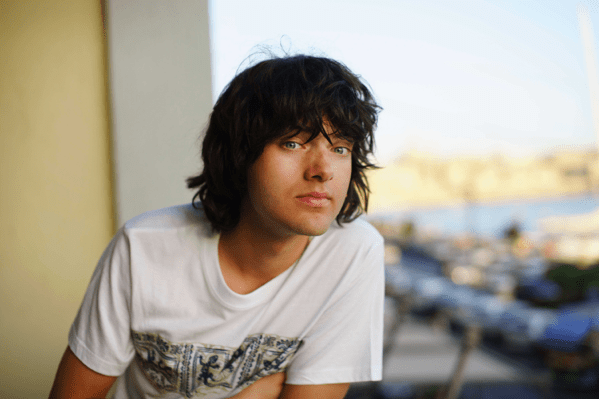“For society to progress, we should not only move forward but also cleanup after ourselves.”1

By NOAA | Courtesy of Wikimedia Commons
Over the last forty years, our oceans have been filling with tons of plastic debris. The plastic is carried by the ocean currents and it all converges in five major accumulation zones, commonly called “Garbage Patches.”2 Many scientists predict that if this problem is not solved, there will be major consequences. Garbage will block the sunlight in the oceans, resulting in many species of sea plants and animals dying. Moreover, the environment will be affected in such ways that the entire food chain of the world will suffer major changes. Dutch inventor Boyan Slat has come up with an idea to solve this problem.3
Boyan Slat is a 24-year-old Dutch inventor, who has been interested in engineering projects since he was very young. At the age of fourteen, he even set a Guinness World Record by launching 213 water rockets at the same time.4 When he was sixteen, he went diving in the waters of Greece and was so surprised to see more plastic underwater than fish. That was the moment when Slat began the idea of cleaning up the ocean. Over the last forty years, millions of tons of plastic have entered the oceans creating huge garbage patches. The largest such patch is located between Hawaii and California. After his trip to Greece, Boyan became obsessed with this problem. During high-school, all of his science projects were about understanding this problem and trying to solve the “million-dollar” question “why this cleanup is considered impossible?”5

After high-school, Boyan was invited to TEDtx to tell the world his idea. At first, his ideas didn’t seem to be really interesting to the public, so he went on with his life. He started working as an aerospace engineer in TU Delft, but he just couldn’t let go of his idea. But the simple thought of not being able to come up with a solution to this major problem was killing him. He was thinking about the terrible consequences, in several years, for the planet if no one did anything.6
After several months he came into the spotlight again because some news sites had picked up his TED speech and became interested in his story. Slat even dropped out of college to pursue his dream.7
He had always enjoyed solving problems and puzzles. But this time was going to be different. This time the puzzle was to get rid of the plastic in the oceans. He just had to find the perfect pieces to accomplish that. At the young age of eighteen, he founded a non-profit organization called The Ocean Cleanup, in order to develop new technology to tackle this almost impossible task.8
And this is when the real adventure began for Slat. Instead of picking up all the plastic bottles with nets, which according to experts it would cost millions of dollars and take thousands of years, his idea was to use the power of natural currents to gather plastic into long floating rubber barriers. But developing this great plan wasn’t an easy task. It required money, time, and many experts in different fields. In an interview, Slat said “When I started, I thought I would likely fail, and I still might, but considering the scale of the problem, it was important to at least try.”9
His ideas started coming together when several experts, such as engineers, oceanographers, recycling companies, and scientists volunteered to complete a study, which ended up indicating that the The Ocean Cleanup project had a feasible and viable method for removing large amounts of plastic. But this was only the first step. Slat still needed a lot of money to start the project. So his next step was to take his story and project to the rest of the world. He has since gained the support of 160 countries, 38,000 funders, and collected over 2 million USD. With this money, he was closer to accomplishing his dream, but, again, this was just another piece of a big puzzle.10

Later, The Ocean Cleanup started developing prototypes, then getting into trials, failing and learning from mistakes, and finally the got it right. They mapped an area of 3.5 million squared kilometers of plastic and marine debris, known as the “great pacific garbage patch.” After that, Slat gave an interview arguing that most people had an image of this patch as an island where you can practically walk on, but that couldn’t be more wrong. It stretches for millions of kilometers and it would take thousands of years to clean it up.11 So he targeted that area to clean first. The first Ocean Cleanup system was launched on September 8, 2018. He is hoping to clean up to 50% within five years.12
This amazing story is only getting started, so if you want to follow the progress of this project, you can follow their official organization page (www.theoceancleanup.com).
- The Ocean Cleanup, “The largest Cleanup history,” The Ocean Cleanup, June 6, 2017. Accessed September 8. www.theoceancleanup.com. ↵
- NOAA, “Great Pacific Garbage Patch,” National Geographic, June 5, 2015. Accessed September 8. https://www.nationalgeographic.org/encyclopedia/great-pacific-garbage-patch/. ↵
- U.S. Government Publishing Office, “Endangered status for North Pacific and North Atlantic Right Whales,” (Federal register: Vol. 73, No. 45. Thursday, 2008), 12024-12030. ↵
- Viveke Venema, “The Dutch boy mopping up a sea of plastic,” BBC News, October 17, 2017. Accessed September 7. https://www.bbc.com/news/magazine-29631332. ↵
- Susan Caminiti, “Thiel backing 22-year-old’s dream to clean up world’s oceans,” CNBC.com, April 22, 2017. Accessed September 5. https://www.cnbc.com/2017/04/20/thiel-benioff-backing-22-year-olds-dream-to-clean-up-worlds-oceans.html. ↵
- The Ocean Cleanup, “How it all began,” The Ocean Cleanup, June 6, 2017. Accessed September 8. www.theoceancleanup.com. ↵
- The Ocean Cleanup, “How it all began,” The Ocean Cleanup, June 6, 2017. Accessed September 8. www.theoceancleanup.com. ↵
- Susan Caminiti, “Thiel backing 22-year-old’s dream to clean up world’s oceans,” CNBC.com, April 22, 2017. Accessed September 5. https://www.cnbc.com/2017/04/20/thiel-benioff-backing-22-year-olds-dream-to-clean-up-worlds-oceans.html. ↵
- Viveke Venema, “The Dutch boy mopping up a sea of plastic,” BBC News, October 17, 2017. Accessed September 7. https://www.bbc.com/news/magazine-29631332. ↵
- The Ocean Cleanup, “Milestones,” The Ocean Cleanup, June 6, 2017. Accused September 8. www.theoceancleanup.com. ↵
- Marian Liu, “Great Pacific Garbage Patch Now Three Times the Size of France,” CNN, 23 Mar. 2018. Accessed September 6 2018. www.cnn.com/2018/03/23/world/plastic-great-pacific-garbage-patch-intl/index.html. ↵
- The Ocean Cleanup, “Milestones,” The Ocean Cleanup, June 6, 2017. Accessed September 8. www.theoceancleanup.com. ↵



78 comments
Nathan Hartley
Where I live, there are constantly people doing community service cleaning up the sides of the road because of all the trash that passing cars throw out of their windows. The amount of trash that get left out in the public makes me angry, but I think that if we get more innovators working towards solutions, we can help clean up the Earth and make it last for suture generations.
Tyanne Pearcy
It is insane how much the human population doesn’t realize how much they are hurting the earth with the amount of littering that occurs on a daily basis. I was not informed on the garbage patch until now but it is disheartening to know that trash the size of Texas is floating in the middle of the ocean. I am glad that Boyan Slat was inspired enough to try and take action to this growing problem by conducting projects to clean up the trash engulfing the oceans.
Mason Meza
Seeing trash anywhere is very upsetting because it starts as one piece but ends up to be five times the size of Texas. I am the type of person where if I see something on the ground I will pick it up and throw it away. It enlightens me to see that we are starting an organization to help clean the environment. I hope that people will wake up and see what they are doing to their home and to the world. This article was very interesting to read. The author did a very good job on writing it.
Maggie Amador
We need more innovative people like Boyan Slat moving forward to help bring solutions to “impossible” problems to help save the Earth. I think as we continue to rapidly grow as a population we need to not only begin fixing our current environmental issues but begin to worry about the future ones. I truly believe if efforts continue Slat’s goal of cleaning up 50% of the ocean’s garbage is possible, but I wonder where/what he plans to do with the garbage?
Nathalie Herrera
This subject is one of great concern and it is sad to read that the build of plastic is getting out of hand. Luckily, more creative minds such as, Boyan Slat, are conducting solutions and putting them into action. The status of the environment is not a subject to brush off but to take into serious concern especially with all the build up of trash within our oceans. Really interesting and great read!
Aneesa Zubair
I learned about the garbage patch in high school; it’s amazing to see that new solutions to this problem are being developed. Slat has a very interesting but heartbreaking story about how he discovered more plastic underwater than fish. I’m glad this inspired him to search for solutions and start the Ocean Cleanup Project. The Pacific Garbage Patch is a dangerous issue that often gets overlooked, and we need innovators like Slat to find realistic solutions to this problem.
Michael Hinojosa
It’s horrifying to know that theres a giant island of trash the size of Texas just floating in the middle of the ocean and the media isn’t doing anything within their power to let us know that this exists! We all know Texas is a huge place so I can only imagine how much trash had to be collected in order to form an island as big as the largest state in the United States.
Noah Bolhuis
I think this is a great idea. Cleaning half of all that rubbish in five years seems extremely ambitious, but I hope that it can happen. It is disappointing that it took so long for someone to actually try to do anything about this growing issue, but better late than ever. Also, if 160 countries and 38,000 donors actually sponsored and donated money to this organization, I would expect that the company would get much more than 2 million dollars. But this is a great project and I will be sure to follow its progress.
Andrea Cabrera
This article did an amazing job at highlighting a problem that has began to hit the planet’s ecosystems. The first step to change is getting informed to prevent any more pollution in the World. There are many organizations and individuals who are willing to try to prevent any further destruction of the ocean environment and ecosystem. This is my first time reading about this project, and we can take a moment to admire this man’s determination to complete his mission. All we can do now is try to be more environmental friendly and have faith in people like him, who are willing to repare the damages that have already been done.
Nathan Alba
I also think it brings to light a problem not everyone is aware of. A garbage patch the size of Texas? That has got to be a lot of trash. But at least there is someone who is willing to try and pick up, and further prevent the destruction of the ocean environment and ecosystem. Who knows what the outcome could be if there was no plan to try and fix this mass scale problem. Overall I thought the article was put into great words.